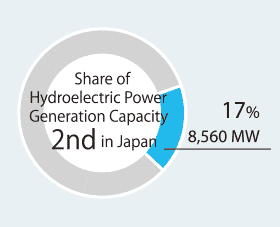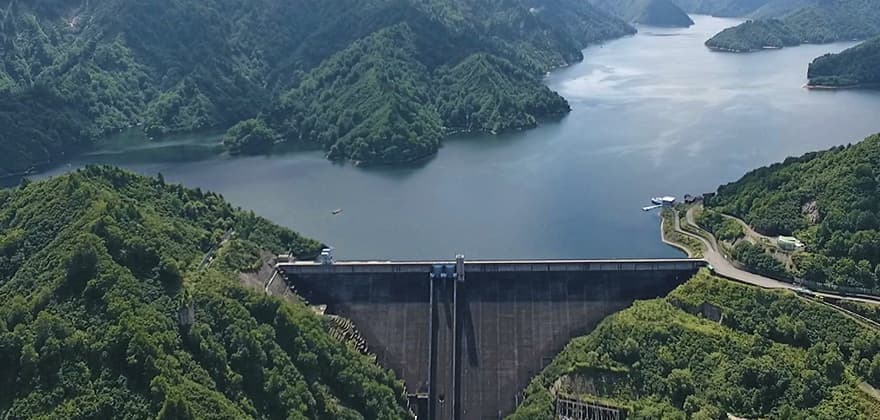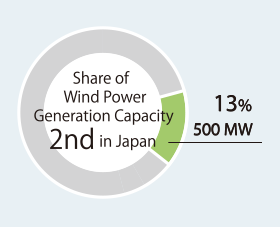- Home
- Business Overview
- CO2-Free Power Sources
CO2-Free Power Sources

The Increasing Importance of Realizing Carbon Neutrality
The J-POWER Group is involved in approximately 100 renewable energy projects. In Japan, renewable energy-related facilities account for roughly half of the J-POWER Group’s domestic power generation facilities. As one of Japan’s leading renewable energy business operators, the J-POWER Group will continue to leverage its abundant expertise and technical prowess, maximize value through the upcycling of existing facilities, and accelerate new development.
In overseas business, the J-POWER Group has been accelerating the expansion of renewable energies, including participation in the Triton Knoll Offshore Wind Farm Project in the United Kingdom and solar power generation business in Australia and other countries.
The capacity of overseas renewable energy projects being newly constructed or developed is comparable to the same scale as the renewable energy that the Group is currently operating overseas.
Hydroelectric Power

CO2-Free Power Generation and Hydroelectric Power

Over more than 70 years, the J-POWER Group has engaged in the development and operation of hydroelectric power plants. Hydroelectric power is CO2-free and output can be easily adjusted, thereby helping to supply power during peak demand and stabilize the power network. The J-POWER Group has extensive knowledge of large-scale hydroelectric power development as a result of its participation in the electric power business from the initial stages of national land development. In Japan, the Group is involved in nearly 20% of all hydroelectric power facilities, with 60 locations and total owned capacity of 8,560 MW. Overseas, the Group has 485 MW hydroelectric power facilities in China and the Philippines, and is executing a new pumped storage power project in Australia.
With competitiveness that capitalizes on low costs that come from long-term operation, the J-POWER Group is conducting replacement work to boost the reliability and power generation efficiency of existing facilities. The Group is also developing small and medium-scale hydroelectric power plants to further utilize hydropower resources.

Major Projects under Construction or Development
(As of September 30, 2022)
| Project Name | Country | Owned Capacity (MW) |
|---|---|---|
| Onabara (Small and medium-scale hydroelectric power) | Japan | 1.0MW |
| Ashoro (Repowering) | Japan | 42.3MW |
| Ogamigo (Repowering) | Japan | 20.0MW→21.3MW |
| Nagayama (Repowering) | Japan | 37.0MW→39.5MW |
| K2-Hydro (Pumped hydroelectric) | Australia | 19.3MW |
| Sweetheart Lake (development) | United States | 1.98MW |
Wind Power


The J-POWER Group was among the first to enter the wind power business in Japan. By consistently applying its engineering capabilities from surveys to construction, transmission line installation, operation and maintenance, the Group’s involvement in domestic power generation facilities ranks as the second largest. Today, in addition to seeking out new development projects in various regions, the Group is working to raise generation capacity through replacement of aging facilities.
Offshore Wind Power
Offshore wind power takes advantage of more consistent wind speeds compared to locations on land, and allows for construction of larger wind turbines. For these reasons, the full-scale development of offshore wind farms is expected in Japan given that it is an island nation. The J-POWER Group continues to acquire knowledge from its participation from the initial stages in the Triton Knoll Offshore Wind Farm Project in the United Kingdom, construction of which was completed in 2022, and is aiming to develop large-scale offshore wind power generation in Japan as well.
Major Projects under Construction or Development
(As of September 30, 2022)
| Project Name | Country | Owned Capacity (MW) |
|---|---|---|
| Onshore (Construction / Replacement) (Under Construction / Preparing for construction) |
Japan | 360MW |
| Onshore (more than 10 areas) (Under EIA) | Japan | 710MW |
| Onshore, Kidston Stage-3 Wind (Preparing for development) | Australia | 81MW |
| Offshore (four areas) (Under research for development) |
Japan | A maximum of approximately 1,850MW |
Geothermal Power

Geothermal power is a CO2-free energy source that can generate stable power regardless of weather. J-POWER has been involved in geothermal power generation for approximately 50 years. In 2019, the Wasabizawa Geothermal Power Plant* began operations as the first new plant in Japan in 23 years, with an installed output of over 100 MW. Currently, J-POWER is carrying out replacement construction and new construction of geothermal power plants in Japan, and conducting studies for new development.
- *A joint venture with Mitsubishi Materials Corporation and Mitsubishi Gas Chemical Company, Inc.
Major Projects under Construction or Development
(As of September 30, 2022)
| Project Name | Country | Owned Capacity (MW) |
|---|---|---|
| Onikobe (Replacement) | Japan | 14.9MW |
| Appi | Japan | 2.2MW |
| Takahinata-yama area | Japan | Under research for development |
Solar Power

The J-POWER Group is promoting the development of large-scale solar power plants by utilizing its expertise in location, grid/market analysis, operation and sales related to power plant construction. In the United States, the Group is planning development of solar energy and storage facilities, taking advantage of the abundant sunlight in certain regions. In Australia, the Group has invested in renewable energy company Genex Power Ltd., and will carry out development in cooperation with that company. In Thailand, the J-POWER Group is installing photovoltaic systems on the rooftops of factories and other buildings to answer the decarbonization requirements of existing customers.
Major Projects under Construction or Development
(As of September 30, 2022)
| Project Name | Country | Owned Capacity (MW) |
|---|---|---|
| Hibikinada | Japan | 30MW |
| Oshio | Japan | 2MW |
| Refugio | United States | 100MW |
| Rooftop solar business(4 sites) | Thailand | 3.3MW |
Biomass

In Thailand, the J-POWER Group has been participating in sustainable biomass power generation using rice chaff and rubber wood waste for about 20 years.
Major Projects
(As of September 30, 2022)
| Project Name | Country | Owned Capacity (MW) |
|---|---|---|
| Roi-Et (Chaff) | Thailand | 2.1MW |
| Yala (Rubber wood waste) | Thailand | 9.9MW |
Construction of Nuclear Power

Nuclear Power as a CO2-Free Energy Source
The Ohma Nuclear Power Plant provides CO2-free energy, and will be able to consistently generate a large amount of electric power once it comes on line. Given its ability to use mixed oxide (MOX) fuel, which is made from recycled spent fuel discharged from nuclear reactors, the plant will contribute to the stable supply of nuclear power in Japan and help to reduce national CO2 emissions. In addition, because it will operate using recycled spent fuel generated domestically, it will also contribute to raising the energy self-sufficiency of Japan, which is a country poor in natural resources. The J-POWER Group is placing top priority on ensuring safety as it carries out the Ohma Nuclear Power Plant project.
